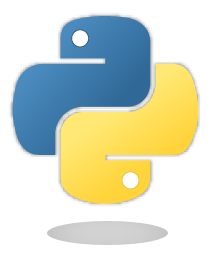Python Tutorial 学习(三)--An Informal Introduction to Python
3.1. 将Python用作计算器
3.1.1. Numbers 数
- 作为一个计算器,python支持简单的操作,
- '+','-','*','/'地球人都知道的加减乘除.
- ()可以用来改变优先级,同数学里面的四则运算优先级一样.
- '='用来建立起表达式和变量间的联系,通俗点讲就是赋值. Afterwards, no result is displayed before the next interactive prompt (没看明白...)
- 变量在使用之前必须被定义.
- 浮点型的支持:用python进行数学计算的时候,python会帮你处理小数(float)和整数(integer)间的关系(存在小数的时候,那么得到的结果必然是一个浮点型的).
- 复数的支持:复数虚步在python里面需要带上j或者J的后缀,实部非0的复数表示为 (real + imagj),或者也可以用complex(real, imag)函数来生成.
复数z的实部与虚部可以通过z.real和z.imag获取
类型转换函数float(), int() and long()对复数无效
用abs(z)获取它的magnitude (as a float) 或者通过 z.real 的方式获取它的实部
- 交互模式下(命令行),最后输出的一个表达式会被赋给变量 '_',所以有时候可以通过使用 '_' 简化操作
This variable should be treated as read-only by the user. Don’t explicitly assign a value to it — you would create an independent local variable with the same name masking the built-in variable with its magic behavior.
3.1.2. Strings 字符串
除了数之外,Python同样的有多种处理字符串的方法.
字符串的三种表达方式:
- 'This is a string'
- "This is another string"
- """This is also a string"""
扩展一下
'Hello I'm zhangsan' Wrong
'Hello I\'m zhangsan' Right
"Hello I'm zhangsan" Right
此外,还有一种字符串的表示需要提一下,那就是
r'this is a string and something like \n will not work it you wanna to converted it to newline'
r '' 也就是raw的意思,被其包围的字符串都会原样的输出,像\n \t等等的这时候就不会被转换成换行和回车,但是直接的回车换行就会生效,比如说这样
print r'Hello, I am \
zhangsan'
输出会是这样的
Hello, I am
zhangsan
字符串是可以使用 + 和 * 操作的
比如 'this is a string'和 'this is ' + 'a string' 得到的结果是一样的
'aaa' 同样的也可以表示为 'a' * 3
同list一样的,string也可以切片,比如说
print 'abcde'[:3] # abc
print 'abcdefg'[0:4:2] #ac
for w in 'words':
print w,
#output:
w o r d s (注意我在print后面用了一个逗号,这样不会换行)
len('abc') 得到的结果是字符串 'abc' 的长度(3)
所以上面的一个for循环也可以这样:
for i in range(len('words')):
print 'words'[i],
这会得到同样的结果
3.1.3. Unicode Strings
定义一个Unicode字符串简单的同定义普通字符串一样
Creating Unicode strings in Python is just as simple as creating normal strings:
由于太简单了,所以我就不写了(哈哈,其实是我不知道怎么去说....)
3.1.4. Lists
序列作为Python的基本格式之一,简直是妙极了.这里简单的用几个小例子来介绍一下list的使用方法.
定义一个序列,看起好像有点复杂,其实不复杂.
lst = [0, 1, 2, 3, 4, 5, 'a', 'b', [8, 888], '9', {'10': 10, 10: 100}]
lst[1] # 1 一个整数
lst[8] # [8, 888] 一个序列
lst[9] # '9' 一个字符串
lst[10] # {'10': 10, 10: 100} 一个字典
看起来好像很灵活的样子,就是这么任性.
list的切片
lst[2:6] #[2, 3, 4, 5, 'a']
lst[2:6:2] #[2, 4, 'a']
lst[-1:0:-1] #[{'10': 10, 10: 100}, '9', [8, 888], 'b', 'a', 5, 4, 3, 2, 1] 其实就是一个逆序
lst[-1:0:-2] #[{'10': 10, 10: 100}, [8, 888], 'a', 4, 2]
len(lst) # 10
3.2. First Steps Towards Programming
Python可不仅仅是用来做加减乘除的,比如,这里我们可以用它来实现一个斐波那契数列(一对兔子,三个月生小兔子.........)
>>> # Fibonacci series:
... # the sum of two elements defines the next
... a, b = 0, 1
>>> while b < 10:
... print b,
... a, b = b, a+b
#output
1 1 2 3 5 8
关于这个函数,后面会有更为详细的介绍(直接定义了一个函数出来了)


 An Informal Introduction to Python: Python中的数,字符串,序列
An Informal Introduction to Python: Python中的数,字符串,序列

